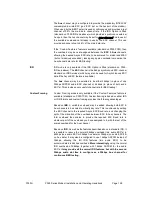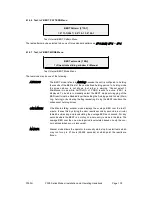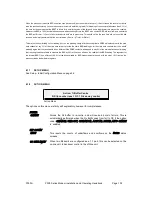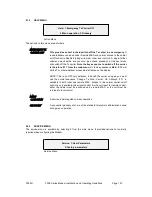
P300H
P300 Series Modem Installation and Operating Handbook
Page 143
8.2 DETERMINING CLOCKING SCHEMES AND BUFFER SIZE
Please note that unless the clocking scheme has been discussed
and agreed
by both ends of the link, it
is unlikely to work reliably!
You need to know the following things:
Incoming Rx carrier :
1.
Is your Tx clock looped back to you at the distant end?
2. If not, what is the accuracy of the clock they are transmitting.
Outgoing Tx carrier:
1. Are you looping the incoming Rx clock (Tx Clock = Rx, or clock looped
by the equipment or cables your end).
2. If not, what is the accuracy of your Tx clock
Follow these guidelines:
8.2.1
Clock Loop At One End:
The end
with the clock loop
requires
Buffer disable
(Rx Clock =
Í¿¬»´´·¬»
). If there is either a cabled
clock loop or the equipment loops the Rx clock back to the modem Tx input then set Tx clock =
̨ Ý´µ ײ
.
If there is no physical clock loop set the Tx clock =
Ψ
.
The end
without the loop
requires the buffer active and set for 2 x Doppler shift only as there is no
Plesiochronous effect with a clock loop. The Buffer size required depends on the satellite orbit (or rather
the accuracy with which it's position is maintained), currently 2ms (end to end) buffering is enough for
the Doppler shift from 1 satellite hop on current INTELSAT satellites. For 2 x Doppler shift 4ms is
required.
Set the Tx & Rx Clock modes as follows to use the clock listed:
Clock from the interface / terrestrial network
Tx Clock =
̨ Ý´µ ײ
, Rx Clock =
̨ Ý´µ ·²
Modem internal clock
Rx Clock =
ײ¬»®²¿´
and feeds the clock to the terrestrial equipment. If the Rx output clock is
externally looped by equipment or in cable then set Tx Clock =
̨ Ý´µ ײ
. If the Rx output clock is not
returned to the modem Tx input by the equipment or the cable then set Tx Clock =
Ψ Ý´µ
.
Station clock
Rx Clock =
ͬ¿¬·±²
, Tx Clock as for "Modem Internal Clock" above.
Satellite
Not possible, with clock loop at distant end, Rx satellite clock is
already
a copy of our Tx clock we
cannot loop it again.
8.2.2
No Clock Loop
If there is no clock loop, then both ends need the Buffer active to cope with the normal Doppler effect,
plus the plesiochronous effect (ie the difference between the clocks at each end). Apply the following
rules to both ends:
















































